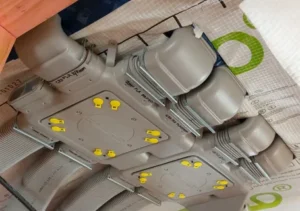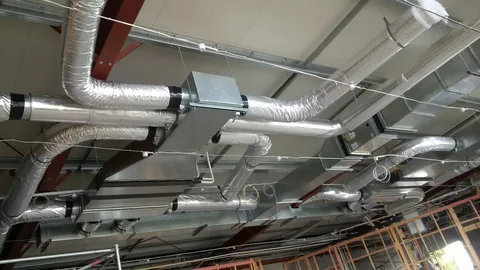When it comes to home comfort, the often-overlooked heat vent plays a pivotal role in creating a cosy and energy-efficient environment. With the rising energy costs, homeowners are increasingly seeking ways to enhance the efficiency of their heating systems. In this blog post, we will delve into the essential aspects of heat-vents and HRV systems, exploring their importance, cost factors, and tips for choosing and installing the right system for your home.
Understanding the Basics of Heat Recovery Ventilators
Understanding the basics of heat recovery ventilators (HRVs) is essential for homeowners looking to improve indoor air quality while maintaining energy efficiency. HRVs exchange stale indoor air with fresh outdoor air, capturing heat from the outgoing air to preheat the incoming air during colder months. This process reduces energy loss and ensures a continuous supply of fresh air, which is crucial for a healthy living environment.
Typically, an HRV consists of two air streams: one for incoming fresh air and one for exhaust air. As these streams pass through a heat exchanger, the heat from the outgoing air warms the incoming air, minimising the energy needed for heating. This technology is particularly beneficial in tightly sealed homes with limited natural ventilation.
HRVs are equipped with filters to remove dust and allergens, enhancing indoor air quality. They can also help control humidity levels, reducing the risk of mould and other moisture-related issues. When selecting an HRV, consider factors such as the size of your home, climate conditions, and specific ventilation needs.
The Importance of Proper Heating Vents in Your Home
Proper heating-vents are essential for maintaining a comfortable and energy-efficient home. They play a critical role in the overall heating system, ensuring warm air is effectively distributed throughout living spaces. When correctly installed and maintained, heating-vents help eliminate cold spots, creating a consistent and pleasant indoor environment.
One of the primary benefits of proper heating vents is improved energy efficiency. When vents are positioned optimally, the heating system doesn’t have to work as hard to maintain the desired temperature, reducing energy consumption and lowering utility bills. This efficiency saves money and contributes to a more sustainable household. Properly functioning heating-vents promote better indoor air quality.
Allowing for adequate airflow helps prevent the buildup of allergens and pollutants, ensuring that the air circulating in the home is clean and healthy. Regular maintenance of heating-vents is also vital. Dust and debris can accumulate, obstructing airflow and reducing efficiency. By keeping vents clean and free from obstructions, homeowners can enhance the performance of their heating systems.
Enhancing Energy Efficiency with Heat-Vents
Enhancing energy efficiency with heat-vents is crucial for reducing energy costs and promoting a sustainable living environment. Heat-vents play a significant role in distributing warm air throughout a space, ensuring that every room reaches a comfortable temperature without the heating system working overtime. When installed correctly, these vents help optimise airflow, allowing warm air to circulate effectively while minimising heat loss.
This is particularly important in larger homes or spaces with complex layouts, where poorly placed vents can lead to cold spots and inefficient heating. Regular maintenance of heat-vents contributes to energy efficiency. Dust and debris can accumulate, obstructing airflow and forcing the heating system to work harder. Homeowners can ensure that their systems operate at peak performance by routinely cleaning the vents and inspecting the ductwork for leaks.
Another effective strategy is installing energy-efficient models with features like adjustable airflow and built-in timers. These innovations allow greater control over heating, enabling users to tailor the system to their needs and schedules. Integrating smart home technology with heat-vents can significantly enhance energy management. Smart thermostats can monitor temperature changes and adjust settings accordingly, optimising energy use throughout the day.
Factors Influencing the HRV System Cost
Several factors influence the HRV-system cost, impacting the overall investment required for installation and maintenance.
- System size and capacity play a crucial role. Larger homes typically require more powerful HRV systems to ensure adequate ventilation, which increases the initial purchase price.
- System features significantly affect costs. Advanced models with additional functionalities like humidity control and smart home integration are more expensive than basic units.
- The quality of components used in the HRV system can influence pricing. High-efficiency filters and durable materials generally come at a premium but can enhance performance and longevity.
- Installation complexity is another critical factor. If the installation requires extensive ductwork modifications or upgrades to existing systems, this can increase labour costs.
- Regional market conditions can impact HRV system cost. Prices may vary based on local demand, availability, and competition among suppliers and installers.
- Consider ongoing maintenance and operational expenses. Higher-quality systems might have lower long-term costs due to increased energy efficiency and durability, making them a more cost-effective choice over time.
Homeowners can make informed decisions regarding their HRV system investments by understanding these factors.
 Choosing the Right HRV for Your Home
Choosing the Right HRV for Your Home
Choosing the correct heat recovery ventilation (HRV) system for your home is crucial for ensuring optimal indoor air quality and energy efficiency. Here are some essential tips to help you make the best decision:
Assess Your Home’s Size
Start by evaluating your home’s size. The HRV system’s capacity should match your home’s square footage to ensure adequate ventilation. Look for units that specify airflow rates, usually measured in cubic feet per minute (CFM), to find one that fits your space.
Consider Your Climate
Different climates have varying ventilation needs. In colder regions, look for an HRV with a high-efficiency heat exchanger to maximise heat recovery. In milder climates, a system with adjustable settings may be more beneficial.
Evaluate Noise Levels
Noise can be a significant factor when selecting an HRV. Look for models that offer quieter operation, especially if the unit will be installed near living spaces. Reading user reviews can provide insights into noise levels during operation.
Check Maintenance Requirements
Some HRV systems require more maintenance than others. Consider how easy it is to access filters and components for cleaning and replacement. Choosing a model with low maintenance needs can save you time and effort in the long run.
Seek Professional Advice
Consulting with an HVAC professional can provide valuable guidance tailored to your needs. They can help you assess your home’s ventilation requirements and recommend the most suitable HRV system for optimal performance.
Determining the HRV Price
When evaluating the HRV price, looking beyond the initial purchase cost is essential. Prices vary based on unit size, advanced features, and installation complexity. For example, a larger home may necessitate a more powerful HRV, increasing expenses. Units with smart controls or superior filtration systems tend to be more expensive.
Additionally, installation costs can rise if extensive ductwork or complex integration with existing systems is needed. However, long-term savings from reduced energy usage and improved indoor air quality often offset these upfront costs. To ensure a sound investment, consider both the immediate and long-term financial implications of your chosen HRV system.
Installation Tips for Heat-Vent Systems
Installing a heat-vent system requires careful planning and execution to ensure optimal performance and efficiency. Here are some essential tips for a successful installation.
- Assess Your Space: Before installation, evaluate the layout of your home. Identify areas that require heating and consider the placement of furniture, windows, and doors. This assessment will help determine the best locations for the vents.
- Choose the Right Size: Selecting the appropriate size of heat-vent is crucial. Too small vents may not distribute heat effectively, while oversized vents can lead to energy wastage. Refer to the manufacturer’s guidelines or consult a professional for accurate sizing.
- Consider Ductwork: Ensure that the ductwork is properly sized and insulated to minimise heat loss. Insulated ducts help maintain the air’s temperature, enhancing overall system efficiency.
- Placement Matters: Install heat-vents near the floor, as warm air rises. Strategic placement in high-traffic areas can promote even heat distribution throughout the room.
- Seal Gaps: After installation, check for any gaps or leaks in the ductwork and seal them appropriately. This prevents air loss and ensures that the system operates efficiently.
- Regular Maintenance: Plan for routine maintenance, including cleaning vents and checking for blockages, to ensure long-term performance and comfort.
Heat Recovery Ventilator Sizing for Optimal Performance
Proper heat recovery ventilator sizing is essential to ensure efficiency and comfort in your home. An appropriately sized HRV system balances adequate ventilation with optimal heat recovery, preventing issues such as poor indoor air quality or excessive energy use. The right size for your HRV depends on various factors, including the square footage of your home, the number of rooms, and your household’s specific ventilation requirements.
To begin with, calculate the total volume of air that needs to be exchanged, typically measured in cubic metres per hour (m³/h). This figure will be influenced by the size and layout of your home and the number of occupants. Also, homes with higher ceilings or multiple levels might require a more robust HRV system to maintain adequate airflow and heat recovery.
Consulting a professional is advisable to assess your needs and accurately recommend a suitable HRV model. This ensures that the system you choose is neither underpowered nor overpowered for your home, optimising performance and cost-efficiency. A correctly sized HRV will provide a healthier, more comfortable living environment while keeping energy consumption in check.
Conclusion
In conclusion, incorporating a heat-vent into a heating system is vital in enhancing home comfort and efficiency. Heat-vents help maintain a consistent temperature, reduce energy consumption, and improve indoor air quality by effectively distributing warm air throughout the space. Understanding their importance allows homeowners to optimise their heating systems, ensuring a cozy environment during colder months. Ultimately, a well-functioning heat-vent is vital to a comfortable living space.
FAQs
How does a heat-vent work?
A heat-vent uses a fan or natural convection to draw warm air from the heating source and push it through ducts or openings into the room. The design allows for adequate heat circulation, preventing cold spots and maintaining an even temperature throughout the space.
Where should a heat vent be installed?
The ideal location for installing a heat vent is typically near the floor, as warm air rises. Placing it strategically in high-traffic areas helps ensure that heat is evenly distributed. Homeowners should consider room layout and furniture placement when deciding on vent locations.
Are there different types of heat-vents?
Yes, there are several types of heat-vents, including wall vents, floor vents, and ceiling vents. Each type is suited for specific applications and room configurations, allowing homeowners to choose the best option for their heating needs.
How do I maintain a heat-vent?
Maintenance of a heat-vent involves regular cleaning to remove dust and debris that can obstruct airflow. It’s also essential to check for any ductwork blockages and ensure the vent is functioning correctly. Routine inspections can help maintain optimal performance.
Can a heat-vent improve energy efficiency?
A heat-vent can enhance energy efficiency by ensuring that warm air is distributed evenly throughout a space. Properly installed and maintained vents reduce the workload on heating systems, leading to lower energy bills and a more comfortable home environment.
| Related Business Listings |
| Contact Directory |
| Local Business Profiles |



